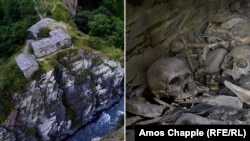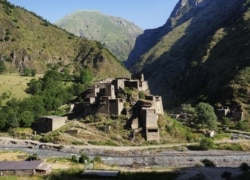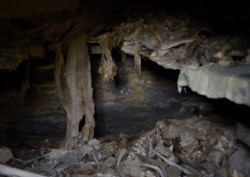Ask locals in Shatili -- a village in Georgia's mountainous north -- what happened inside the nearby stone huts filled with human bones and they will probably tell you a version of the same haunting story. As a plague in a previous century -- no one seems to know exactly when -- was sweeping through the Caucasus, a merchant unwittingly carried the dreaded disease into a village called Anatori.
When the plague -- known in Georgian as "Zhami" -- began to spread, selfless villagers who felt its deathly grip rose from their sickbeds and shuffled toward a lonely bluff where two rivers meet.
There, some threw themselves to their deaths in the swift waters, while others crawled inside stone huts that had been built in advance for such a situation. The villagers laid themselves on the slate shelves inside to await death, consoled by the knowledge that Anatori could live on through their sacrifice -- a kind of self-quarantine taken to heroic extreme.
The story has been reported across both Georgian- and English-language media, including in National Geographic, which claims rather implausibly that the dying villagers “bricked themselves inside, stone by stone.”
In 2019, it was announced that a movie based on the story of Anatori was in the early stages of production.
But Georgian-born Shorena Kurtsikidze, who co-authored a book on the customs of the region around Shatili and now manages the Department of Near Eastern Studies at the University of California-Berkeley, tells RFE/RL there was "no evidence" the story is true and that the traditions of nearby regions of Russia may hold the clue as to why piles of skeletons lie inside the huts.
Kurtsikidze says necropolises where bodies were laid to rest inside stone structures instead of being buried "were widespread in the neighboring [Russian] regions of Chechnya and Ingushetia," and the Anatori burial vaults may be an example -- perhaps the only one of its kind in Georgia -- of the same ritual.
The reason for building necropolises, instead of burying the dead, is not known with certainty, but one theory is that laying the dead to rest above ground was a way of showing respect to the land.
For now, although Kurtsikidze suggests the plague story is perhaps untrue, she admits that "one can only speculate...I wish we had more scientific facts or proof."







